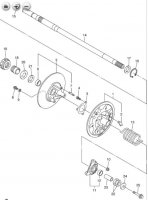steveg_nh
TY 4 Stroke Junkie
- Joined
- Jul 23, 2017
- Messages
- 560
- Reaction score
- 82
- Points
- 238
- Location
- Southern NH
- Country
- USA
- Snowmobile
- 2007 Attak
I'm on my last (can't believe I just wrote that!) project for my Attak, and this I consider general maintenance. LOL.
Anyway, I want to service the secondary, as I have no idea when it was last touched, if at all. The belt sits low in the sheaves (about 2-2.5mm below top), so clutch sheaves could be binding causing it to sit low, or the shims could be wrong. Measured the belt (it's pretty new) and it's right at the new belt width of about 35mm. I have 3 each of the 0.5 and 1mm shims, as I don't know what is already in there.
Anyway, I will be replacing the buttons (ramps), shimming if I need to, but I also want to clean it all up of any dust and crap causing it possibly to bind, and check the bushings. I found a TY video on updating the spring, so that taught me how to remove the helix to get to the buttons. But I still have a few questions and the service manual didn't really answer them. So hoping you guys could help.
1. Is that the only spring (behind the helix)? Meaning, is that the only place I need to worry about spring pressure causing things to fly apart, when I remove those 3 bolts on the helix front?
2. I will pay attention to the helix spring hole locations but in case it pops out on me and I can't tell, what are the settings for the Attak for the spring, is it 6 on the clutch and 1 on the helix? I found a mention of that, but nothing to confirm it. I did install the soft start primary spring from BOP, but my understanding is that doesn't change anything on the secondary holes.
3. To separate the sheaves for cleaning and bushing inspection, I have to pull the clutch from the sled, correct? My understanding is it is the 3 bolts in the back, where you would also shim it, that need to be removed to separate the two sheaves.
4. When checking the 3 bushings in there, is it obvious if they should be replaced? I didn't order them, and figured I'd check them and order if needed.
5. Should I consider a new spring for the secondary? I'm not an off trail rider, and at 44, I'm not nuts either. Just enjoy a nice day on the trails, but I like to grab a whole lot of throttle when I can.
Thanks for the tips!
Anyway, I want to service the secondary, as I have no idea when it was last touched, if at all. The belt sits low in the sheaves (about 2-2.5mm below top), so clutch sheaves could be binding causing it to sit low, or the shims could be wrong. Measured the belt (it's pretty new) and it's right at the new belt width of about 35mm. I have 3 each of the 0.5 and 1mm shims, as I don't know what is already in there.
Anyway, I will be replacing the buttons (ramps), shimming if I need to, but I also want to clean it all up of any dust and crap causing it possibly to bind, and check the bushings. I found a TY video on updating the spring, so that taught me how to remove the helix to get to the buttons. But I still have a few questions and the service manual didn't really answer them. So hoping you guys could help.
1. Is that the only spring (behind the helix)? Meaning, is that the only place I need to worry about spring pressure causing things to fly apart, when I remove those 3 bolts on the helix front?
2. I will pay attention to the helix spring hole locations but in case it pops out on me and I can't tell, what are the settings for the Attak for the spring, is it 6 on the clutch and 1 on the helix? I found a mention of that, but nothing to confirm it. I did install the soft start primary spring from BOP, but my understanding is that doesn't change anything on the secondary holes.
3. To separate the sheaves for cleaning and bushing inspection, I have to pull the clutch from the sled, correct? My understanding is it is the 3 bolts in the back, where you would also shim it, that need to be removed to separate the two sheaves.
4. When checking the 3 bushings in there, is it obvious if they should be replaced? I didn't order them, and figured I'd check them and order if needed.
5. Should I consider a new spring for the secondary? I'm not an off trail rider, and at 44, I'm not nuts either. Just enjoy a nice day on the trails, but I like to grab a whole lot of throttle when I can.
Thanks for the tips!




